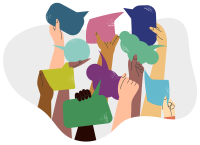Search
There are 5 results.
Tag
Tag
All (44)
Active Learning (3)
Assessments (1)
Asynchrony (3)
Authentic Activities (2)
Backwards Design (2)
Canvas (1)
Case Studies (1)
Collaboration (1)
Communication (2)
Community (3)
Competency-Based Education (1)
Content Creation (5)
Copyright (2)
Course Maintenance (1)
Course Materials (5)
Course Preparation (4)
Discussions (1)
Diversity (1)
Equity (1)
Feedback (5)
Formative Assessments (7)
Game-Based Learning (2)
Gamification (1)
Generative AI (1)
Group Work (2)
Inclusion (2)
Infographics (1)
Learning Objectives (2)
Multimodality (3)
Presentations (1)
Representation (1)
Rubrics (1)
Scaffolding (1)
Summative Assessments (1)
Synchrony (3)
Third-Party Tools (1)
Universal Design for Learning (UDL) (2)
Video (4)
Visual Design (1)
Written Assignments (1)
Copyright
From time to time instructors may want to include in their courses copyrighted materials like images, print content, audio recordings, or videos. The University of Minnesota Libraries define copyright as “the area of law that deals with creation, ownership, sale, and use of creative and expressive works.”
Inclusive Citation
Inclusive citation practices can empower educators to cultivate equity, enrich academic discourse, and create welcoming learning environments. By prioritizing diverse perspectives and ensuring the representation of underrepresented voices, instructors can address systemic inequities in scholarship and amplify marginalized contributions. Such efforts not only deepen students’ critical engagement with course materials but also foster a sense of belonging, preparing them to thoughtfully navigate an increasingly interconnected world.
Inclusive Texts
Today’s student population is diverse and includes marginalized groups that have historically been excluded from mainstream education (Ladson-Billings, 2013). In 2021, students of color comprised upwards of 40% of the 15.4 million undergraduates enrolled in U.S. colleges and universities (Nam, 2024; National Center for Education Statistics, 2023). Ladson-Billings (2013), whose work centers on culturally relevant pedagogy, argues that diverse students require inclusive learning to succeed. “[These students] do not fit neatly into the rigid categories of race, class, gender, or national origin” upon which hierarchies of the past have been built (p. 5), so authentic representation of diversity in higher education is critical. Adrienne Keene, an assistant professor of American Studies at Brown University, writes that instructors can do their part to support underrepresented students by being honest about their own bias and blind spots, critiquing their course materials, and integrating meaningful representations of diversity into the curriculum (Fuchs et al., 2020; Keene, 2015).
How to Set Up Your Canvas Notifications
Did you know you can elect to receive notifications via email related to specific actions in your Canvas account? Notification preferences are applied across your account to all of your courses. However, you can change notification settings for individual courses within each course by clicking View Course Notifications from the home page of the course.





